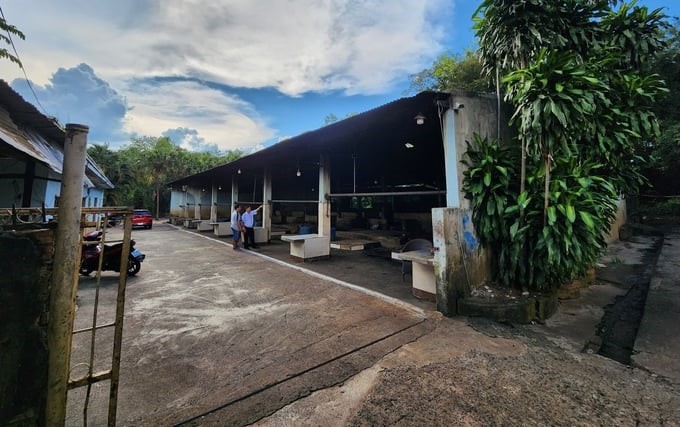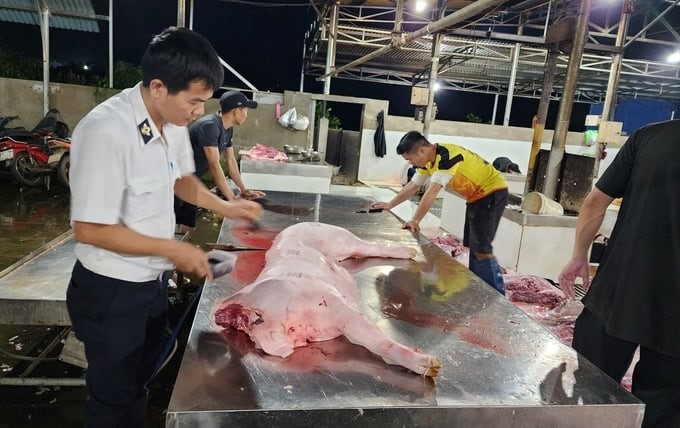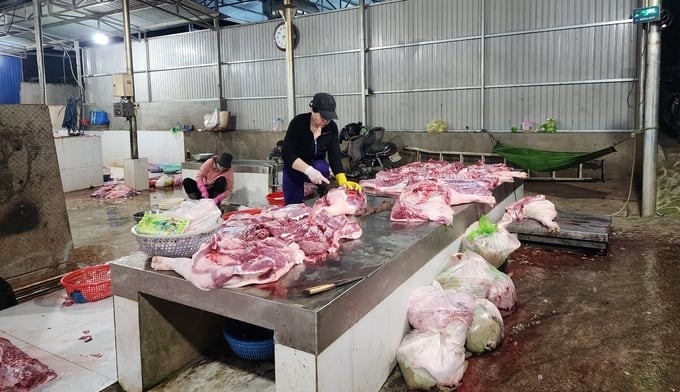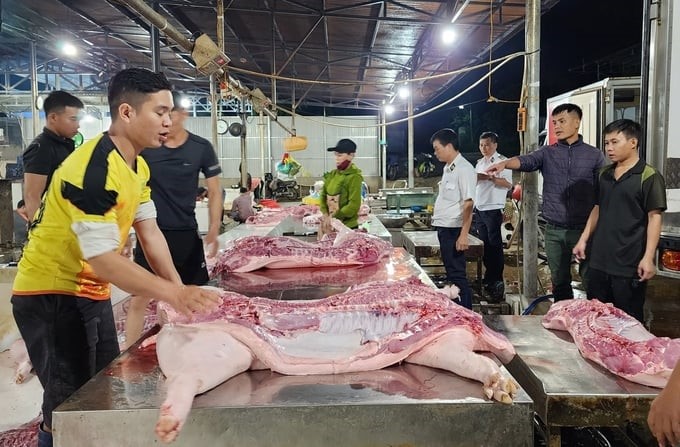May 27, 2025 | 01:53 GMT +7
May 27, 2025 | 01:53 GMT +7
Hotline: 0913.378.918
May 27, 2025 | 01:53 GMT +7
Hotline: 0913.378.918

Slaughter facilities in Dak Lak, mainly invested decades ago, are now degraded and located in residential areas. Photo: Minh Quy.
Concentrated animal slaughter facilities in Dak Lak were mostly built in the 2000s and located interspersed in residential areas near markets. Because they have been in operation for many years, most of them have degraded and caused environmental pollution.
In some districts, there are no concentrated animal slaughter facilities; the slaughter mainly takes place at small animal slaughter facilities, causing slaughter control to not really ensure food safety.
Slaughter activities still take place spontaneously, with many small animal slaughterhouses, while local authorities do not pay attention to managing them but mainly assign the local veterinary force to take charge of slaughter control. Therefore, it is difficult to control.
According to statistics, the entire Dak Lak province has 26 concentrated slaughter facilities and 226 small ones. However, the authorities can only control slaughter at 23 concentrated animal slaughterhouses (3 facilities are temporarily suspended due to a lack of qualifications) and 120 small slaughterhouses.

Veterinary officers stamp quarantine for pigs at slaughter facilities that meet requirements. Photo: Minh Quy.
To manage slaughtering work, the Dak Lak Animal Husbandry and Veterinary Sub-Department authorizes the Animal Husbandry and Veterinary Stations of districts, towns, and the city to sign contracts with commune-level veterinary staff to carry out slaughter control at slaughter facilities and points.
In Dak Lak province, there are many small slaughter points. The form of slaughter at concentrated slaughter facilities is "centralization of slaughtering households". According to Circular 09/2016/TT-BNNPTNT, the existence of the facilities is allowed, but it is difficult to centralize and orient these slaughter points to the concentrated slaughter facilities.
Buon Ma Thuot city is the locality with the most livestock and poultry slaughter facilities in Dak Lak province. However, the current facilities have been invested in for a long time and have degraded.

Currently, Buon Ma Thuot Animal Husbandry and Veterinary Station can only manage nearly 300 pigs, while over 200 heads slaughtered every night have not been controlled but are brought to markets for consumption. Photo: Quang Yen.
Mr. Hoang Anh Dung, Chief of Buon Ma Thuot Animal Husbandry and Veterinary Station, said that the city now has seven slaughterhouses invested in decades ago that have degraded. At present, the station only has the function of checking quarantine work in the slaughterhouse, while the work of checking in the market depends on the local authorities.
“One night, the station could only control the slaughter of nearly 300 pigs, while over 200 heads slaughtered every night have not been controlled but are brought to markets for consumption. Currently, the source of pigs that are not inspected when slaughtered at home and brought to markets for sale is relatively large. This inspection depends on the local authorities, initially the People's Committees of communes and wards. Previously, the City People's Committee established an interdisciplinary team to inspect, but just in a few days," said Mr. Dung.
The Station Chief added that slaughtering at home will affect food hygiene and safety, and environmental pollution. In addition, for households slaughtering at home, it cannot be confirmed that they buy guaranteed pigs. Therefore, spontaneous slaughter will will cause disease spread and unsafety.
“If the city can plan a concentrated slaughter area instead of the current seven points, management will become easier, and it is possible to ensure food hygiene and safety and control the risk of disease spread," Mr. Dung shared.
According to the provisions of Point b, Clause 2, Article 76 of the Law on Veterinary Medicine, the District People's Committee is responsible for "managing the operations of concentrated animal slaughter facilities, pre-processing, processing, transporting, and trading of animals, animal products, and veterinary hygiene in the area".

Buon Ma Thuot Animal Husbandry and Veterinary Station officers inspect pig slaughter at facilities in the area. Photo: Minh Quy.
Mr. Vu Duc Con, Deputy Director of the Dak Lak Department of Agriculture and Rural Development, said that the planning and management of livestock and poultry slaughter and the pre-processing and trading of animal products still have many shortcomings and lack of synchronization from branches, such as the relocation of slaughterhouses located in residential areas. The planning of land location meeting conditions for building a modern, large-scale concentrated animal slaughter facility has not yet received attention.
According to Mr. Con, in most localities in the province, the slaughter of livestock and poultry still takes place spontaneously and in scale in households in residential areas, not ensuring the slaughter control process according to regulations and operating without a license. Local authorities are not really drastic in handling violations of small-scale slaughter activities.
“Supervision of slaughter activities at slaughter facilities and points is only carried out by the veterinary force without the coordination of local authorities. This greatly affects the management of slaughter activities, leading to the slaughter of unhealthy or sick animals. Thereby, poor-quality post-slaughtered animal products without slaughter control marks and veterinary hygiene stamps from veterinary agencies are still circulating in the market, causing a high risk of spreading diseases and directly affecting the health of consumers," said Mr. Vu Duc Con, Deputy Director of the Dak Lak Department of Agriculture and Rural Development.
Translated by Huyen Vu Thu
/2025/05/25/4127-3-073637_820.jpg)
(VAN) Thanks to the promotion from an FAO-implemented project, vegetable production in greenhouses in Moc Chau has seen strong development, from 1.5 hectares in 2021 to nearly 50 hectares in 2024.

(VAN) FAO has recently supported USD 140,000 to implement the project 'Risk mitigation human-animal interface risks through disease control initiatives in pig farming.'

(VAN) The People's Committee of Tra Vinh province has approved an adjustment to the investment policy for the Green Hydrogen Plant project, increasing its area to approximately 52.76 hectares.
![Reducing emissions from rice fields: [2] Farmers’ commitment to the soil](https://t.ex-cdn.com/nongnghiepmoitruong.vn/608w/files/news/2025/05/05/dsc08881jpg-nongnghiep-140632.jpg)
(VAN) Clean rice cultivation model in Thuong Tan commune, Bac Tan Uyen district, is assisting local residents in achieving sustainable agriculture by substantially reducing costs, increasing productivity, and protecting the environment.

(VAN) At the conference to disseminate Resolution No. 68, AgriS introduced its digital agricultural ecosystem and reaffirmed its commitment to accompanying the Government in promoting private sector development and sustainable agriculture.

(VAN) 'Blue Ocean - Blue Foods' initiative is designed to restore marine ecosystems and establish sustainable livelihoods for local communities by cultivating a minimum of 1,000 hectares of cottonii seaweed in the first three years.
/2025/05/21/4642-3-112707_603.jpg)
(VAN) The V-SCOPE project has made direct contributions to three out of six pillars of the Comprehensive Strategic Partnership between Vietnam and Australia.